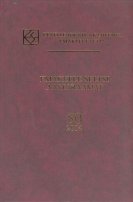Jussiivi kasutusest vanemas kirjakeeles
Use of jussive in the Old Estonian written language
Author(s): Pille PenjamSubject(s): Language and Literature Studies
Published by: Teaduste Akadeemia Kirjastus
Keywords: morphology; speeches; jussive; optative; evidentiality; Old Estonian written language
Summary/Abstract: The verb form ending in gu-/ku- called the jussive in the academic grammar of the Estonian language has many paradigmatically different uses and functions: optative, 3rd person imperative, evidential imperative, and concessive. The article provides an overview of the use of the jussive in the Old Estonian written language and makes an attempt to find out whether the data of the old written language could provide more evidence about the development of functions of the jussive in the Estonian language. The first longer texts in Estonian dating from the 17th century prove that the jussive in the Estonian written language of those days was used it in all of its present-day functions. There are no examples where the jussive could have implied evidentiality, but it can probably be explained by the fact that reported directive sentences are generally rare in any language. Accordingly, the data of the written language cannot reflect essential functional changes in the use of the jussive in the Estonian language as a whole. However, some changes in the use of the jussive can be observed in the written language. Earlier texts may reveal overuse of the jussive caused by the influence of the German Konjunktiv in particular, which has gradually been rejected over the centuries. It is possible to observe the influence of earlier translations of clerical texts on the implementation of new means of expression and to evaluate the originality of the language used by different authors.
Journal: Emakeele Seltsi aastaraamat
- Issue Year: 2004
- Issue No: 50
- Page Range: 068-092
- Page Count: 24
- Language: Estonian

